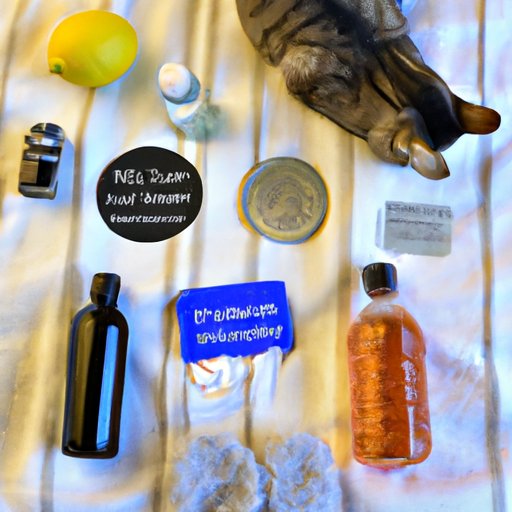
I. Introduction
Fleas on cats can not only cause discomfort and irritation for your feline friend, but also for you as the owner. While there are many chemical treatments available on the market, using natural remedies is a good idea for both your cat’s health and the environment. In this article, we’ll discuss some of the best strategies for getting rid of fleas on cats naturally.
II. Diatomaceous Earth
Diatomaceous earth is a natural, powdery substance comprised of the fossilized remains of microscopic aquatic plants. It works by dehydrating and killing fleas.
To use diatomaceous earth on your cat’s fur, sprinkle a small amount onto your cat’s coat and rub it in with your hands. Be sure to avoid getting it into your cat’s eyes, nose, or mouth. You can also sprinkle it onto your cat’s bedding, carpets, and other surfaces where fleas may be present.
While diatomaceous earth is generally considered safe, it can be dusty and can irritate the lungs when inhaled. Be sure to wear a mask and gloves when handling it, and consider using food-grade diatomaceous earth to avoid exposure to harmful chemicals in products meant for use in pools or gardens.
III. Giving Your Cat a Bath
Bathing your cat with a natural flea repellent shampoo can help remove fleas from their body. Look for shampoos that contain natural ingredients like cedarwood, lavender, or lemongrass.
To give your cat a bath, start by filling a sink or tub with a few inches of lukewarm water. Wet your cat’s coat, then apply the shampoo and work it into a lather. Be sure to avoid getting the shampoo into their eyes, nose, or ears. Rinse your cat thoroughly and towel dry them.
Cats are not typically fans of water, so it’s important to approach bathing with patience and care. If your cat becomes distressed or aggressive, it may be best to try a different flea removal method.
IV. Apple Cider Vinegar
Apple cider vinegar has natural properties that repel fleas. Simply mix equal parts apple cider vinegar and water in a spray bottle and apply it to your cat’s fur, taking care to avoid their eyes, nose, and ears.
While apple cider vinegar is safe for cats when used in moderation, it can be acidic and may irritate your cat’s skin if used too frequently. It’s best to consult with a veterinarian if you’re unsure if this method is right for your cat.
V. Lemon Spray
Another effective natural repellent for fleas is a lemon spray. Simply mix a few tablespoons of fresh lemon juice with water in a spray bottle and apply it to your cat’s coat, avoiding their eyes, nose, and ears.
Like apple cider vinegar, lemon spray should be used in moderation as it can cause skin irritation when used too frequently. It’s also important to note that some cats may not be fans of the scent of lemons.
VI. Flea Comb
Using a flea comb is a physical, non-toxic way to remove fleas from your cat’s fur. Simply run the comb through your cat’s fur, paying special attention to areas where fleas may be present, like their neck and belly. Dip the comb in soapy water between each pass to drown the fleas.
When using a flea comb, it’s important to be gentle and patient, as pulling or tugging on the comb can cause your cat discomfort.
VII. Essential Oils
Essential oils like lavender and peppermint can also be effective at repelling fleas. Mix a few drops of these oils with a carrier oil like coconut or almond oil and apply it to your cat’s coat.
When using essential oils, it’s important to note that cats have sensitive skin and some oils can be toxic if ingested. Be sure to use a high-quality, pet-safe oil and consult with a veterinarian before using this method on your cat.
VIII. Wash Bedding and Carpets
Fleas lay eggs in areas where your cat spends time, like on their bedding or in carpets and furniture. To eliminate flea eggs and prevent re-infestation, it’s important to properly clean and treat these areas.
Wash your cat’s bedding in hot water and vacuum carpets and furniture thoroughly. Consider using a natural flea spray on these areas to kill any remaining fleas or eggs.
IX. Conclusion
By using natural remedies and strategies, you can safely and effectively get rid of fleas on your cat. While chemical treatments may be available, it’s important to keep in mind the potential health risks they pose to both your cat and the environment. Always consult with a veterinarian if you’re unsure about which method to use on your cat.
To keep your cat flea-free, it’s important to maintain a clean home environment and to regularly check your cat for signs of fleas. Remember to also treat any other pets in your household for fleas to prevent re-infestation.





